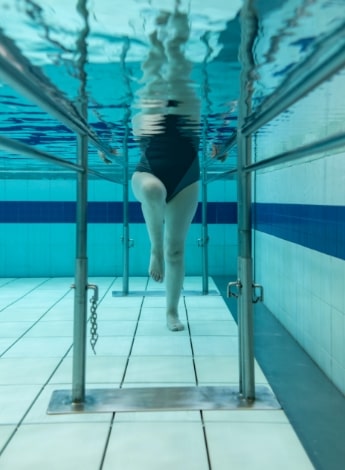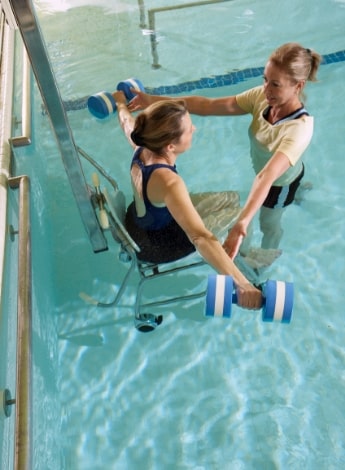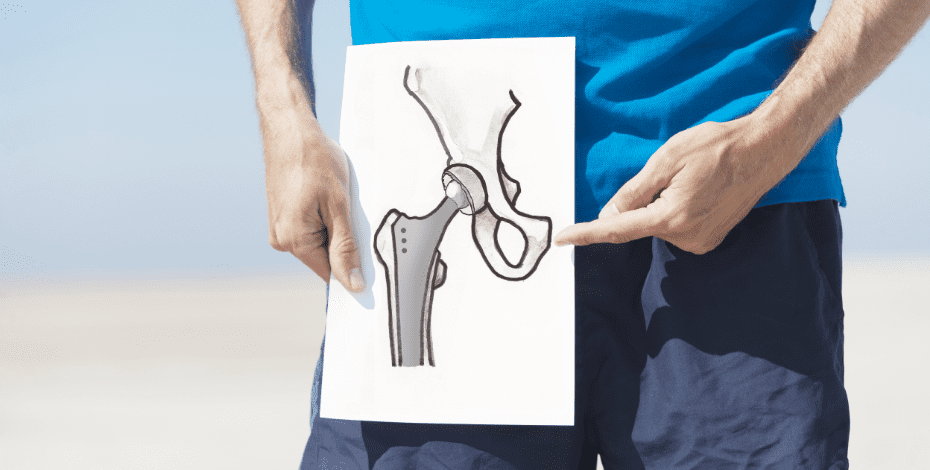
Aquatic physiotherapy

Sophie Heywood, Jillian Chua and Anna Scheer from the Aquatic group present five discussion points about the benefits of aquatic physiotherapy in rehabilitation and the prevention and management of a variety of conditions.
1. Aquatic plyometric training is effective in improving strength, jumping and sprinting
Interest in using plyometric exercises to improve power and function in older adults (Vetrovsky et al 2019) and clinical populations (Cordner et al 2021) is growing.
There may be some value in performing plyometric exercises in water given that buoyancy reduces joint loading in the impact phase.
However, reduced loading in water may also limit performance gains.

The buoyancy of water reduces joint loading and the risk of falling, increasing exercise options for older adults.
In a recent systematic review, aquatic plyometric training was compared with land plyometric training in healthy adults (Heywood et al 2021).
The aquatic plyometric training exercises and dosage exactly replicated the land-based programs in 15 out of 16 studies.
Aquatic training was most commonly performed in waist-to-chest-deep water, 2–3 times per week for 6–12 weeks, with final program foot contacts ranging from 120 to 550.
Aquatic plyometric training resulted in similar improvements in isokinetic knee strength, vertical jump and sprinting compared with land plyometric training.
The strength of conclusions in the review is limited by the quality, number and heterogeneity of the interventions in the included studies.
Although there will be differences in muscle contraction intensity and in the timing, type and speed of movement in aquatic plyometric training compared with land training, lower and slower impact loads in water need to be evaluated to determine effectiveness in rehabilitation programs.
2. Aquatic physiotherapy is beneficial for improving balance and decreasing fear of falling in people with Parkinson’s disease
People with Parkinson’s disease experience recurrent falls, which in turn lead to injury, increased hospitalisations and poor quality of life (Paul et al 2016).
A history of falls, fear of falling, decreased balance, decreased mobility and decreased physical activity have all been identified as common factors associated with recurrent falls (Allen et al 2013).
In two recent systematic reviews (Cugusi et al 2019, Moritz et al 2020), aquatic physiotherapy has been found to be more beneficial than land-based therapy in improving scores in the Berg Balance Scale, the Timed Up and Go Test, postural sway and fear of falling and therefore health-related quality of life for people with Parkinson’s disease with a Hoehn and Yahr score between one and three.
The aquatic interventions used in these studies included strengthening, balance retraining and standardised programs such as Ai Chi, which involves broad movements of the arms, legs and torso combined with deep breathing exercises performed standing in shoulder-deep water.
The dosage and duration of programs varied, from 45 minutes twice a week for four weeks to 60 minutes five times a week for eight weeks.
It is suggested that risk associated with falls and the fear of falling may be reduced in the aquatic environment due to the properties of water.
This means that participants may be more inclined to attempt more challenging exercises in an aquatic environment (Giuriati et al 2021).
3. Aquatic physiotherapy is effective in improving cardiovascular fitness in stroke survivors
It has been recognised that due to ongoing impairments, stroke survivors have increased energy requirements for completing activities of daily living; however, cardiovascular fitness is often reduced in this population (Veldema & Jansen 2021).
It is also important to address this for ongoing secondary stroke prevention.

Aquatic physiotherapy is effective in improving cardiovascular fitness after a stroke.
The aquatic environment may allow stroke survivors to feel more supported, allowing them to reach higher intensities during exercise.
A recent systematic review by Veldema and Jansen in 2021 found that in comparison to land-based interventions, aquatic physiotherapy was more effective in improving cardiorespiratory fitness after stroke in both the subacute and the chronic stroke populations.
Two studies (Han & Im 2018, Lee et al 2018) compared a progressive aquatic treadmill training program with a progressive upper limb and lower limb ergometer training program on land in subacute stroke patients and found greater effectiveness with the aquatic program when measured by a graded treadmill protocol test.
Another study by Chu et al in 2004 demonstrated similar outcomes when comparing aquatic physiotherapy exercises performed at 50–80 per cent maximum heart rate in chest-deep water to land-based upper limb retraining in the chronic stroke population.
Although results were positive, there was minimal follow-up to these studies, so it is not clear whether participants were able to maintain gains in the long term (Veldema & Jansen 2021).
4. Aquatic physiotherapy is effective in improving the strength of the paretic knee in stroke survivors
Lower limb weakness, especially of the knee flexors and extensors, has been linked to limitations in gait, balance and overall function during activities of daily living in stroke survivors.
Studies in both the subacute and the chronic stroke populations have demonstrated that aquatic physiotherapy such as Halliwick (which is based on a structured 10-point program used to develop skills required for independent swimming), Ai Chi and lower limb gait retraining completed for 3–5 sessions per week for eight weeks resulted in statistically significant improvements in knee extensor strength of the paretic knee compared to land-based gym exercise programs.
There were also improvements in knee flexor strength; however, these results were not found to be statistically significant (Dong Koog et al 2008, Zhang et al 2016).
It is suggested that due to properties of the aquatic environment such as water viscosity, the participant is able to better self-regulate the speed of movement, thereby changing the resistance while performing strengthening exercises.
These gains have not been proven to be clinically significant; therefore, results suggest that aquatic physiotherapy may be a beneficial adjunct to land-based therapy for improving overall function (Giuriati et al 2021).
5. Aquatic physiotherapy increases fitness and strength in people with type 2 diabetes
One million Australians have type 2 diabetes (AIHW 2020) and research suggests that approximately 70 per cent do not meet exercise guidelines (Plotnikoff et al 2007).
Physiotherapists should promote exercise in patients with type 2 diabetes, as increased fitness is associated with reduced mortality (Wei et al 2000).
Arthritis is a common comorbidity and may cause discomfort during exercise.

Aquatic exercise improves strength and fitness in people with type 2 diabetes, especially those with common musculoskeletal comorbidities such as arthritis.
Aquatic physiotherapy is well placed to address this, as it reduces the weight-bearing load through the lower limbs and spine.
Aquatic circuit training exercise improved aerobic fitness by 16 per cent in eight weeks, with 13 per cent improvement in leg press strength (Scheer et al 2020).
This included aerobic exercises progressing from 60 to 80 per cent of baseline maximum heart rate and utilised paddles to create drag resistance for strength exercises at a rate of perceived exertion between 12 and 15.
Similar changes in fitness were seen after 12 weeks of aquatic cycling, with a 30 per cent increase in leg strength and improvement in glycaemic control (Suntraluck et al 2017).
Improvements have been seen in vascular function with aquatic training (Scheer et al 2020, Suntraluck et al 2017), which is important given the association between type 2 diabetes and cardiovascular disease.
Considerations for training include foot protection for patients with peripheral neuropathy and access to glucose monitoring and medications.
Aquatic physiotherapy provides an effective, low-impact exercise option for patients with type 2 diabetes, especially with musculoskeletal comorbidities.
Click here for an infographic poster version of this article.
>> Sophie Heywood, APAM, is completing her PhD in closed kinetic chain exercise in water compared to on land and is the Australian representative to the World Confederation for Physical Therapy (World Physiotherapy) Aquatic group. She works at St Vincent’s Hospital and Melbourne Sports Medicine Centre.
>> Jillian Chua, APAM, is the New South Wales representative on the APA Aquatic Committee and a senior aquatic physiotherapist at Graythwaite Rehabilitation Centre, Ryde Hospital. She is interested in furthering aquatic research in the neurological population.
>> Anna Scheer, APAM, is completing her PhD at Curtin University, investigating the effects of aquatic exercise training in people with coronary heart disease. She is passionate about using aquatic exercise to improve health outcomes for people living with chronic disease.
- References
Allen, N. E., A. K. Schwarzel and C. G. Canning (2013). "Recurrent falls in Parkinson's disease: a systematic review." Parkinsons Dis 2013: 906274.
Australian Institute of Health and Welfare (AIHW). Diabetes Canberra: Australian Institute of Health and Welfare; 2020, Cat. no. CVD 82 [16th November 2021]. Available from: https://www.aihw.gov.au/reports/diabetes/diabetes.
Chu, K. S., J. J. Eng, A. S. Dawson, J. E. Harris, A. Ozkaplan and S. Gylfadóttir (2004). "Water-based exercise for cardiovascular fitness in people with chronic stroke: a randomized controlled trial11No commercial party having a direct financial interest in the results of the research supporting this article has or will confer a benefit upon the author(s) or upon any organization with which the author(s) is/are associated." Archives of Physical Medicine and Rehabilitation 85(6): 870-874.
Cordner, T., Egerton, T., Schubert, K., Wijesinghe, T., & Williams, G. (2021). Ballistic resistance training: feasibility, safety, and effectiveness for improving mobility in adults with neurologic conditions: a systematic Review. Archives of physical medicine and rehabilitation, 102(4), 735-751.
Cugusi, L., A. Manca, M. Bergamin, A. Di Blasio, M. Monticone, F. Deriu and G. Mercuro (2019). "Aquatic exercise improves motor impairments in people with Parkinson's disease, with similar or greater benefits than land-based exercise: a systematic review." J Physiother 65(2): 65-74.
Dong Koog, N., J.-Y. Lim, H.-I. Shin and N.-J. Paik (2008). "The effect of aquatic therapy on postural balance and muscle strength in stroke survivors -- a randomized controlled pilot trial." Clinical Rehabilitation 22(10-11): 966-976.
Giuriati, S., A. Servadio, G. Temperoni, A. Curcio, D. Valente and G. Galeoto (2021). "The effect of aquatic physical therapy in patients with stroke: A systematic review and meta-analysis." Top Stroke Rehabil 28(1): 19-32.
Han, E. Y. and S. H. Im (2018). "Effects of a 6-Week Aquatic Treadmill Exercise Program on Cardiorespiratory Fitness and Walking Endurance in Subacute Stroke Patients: A PILOT TRIAL." J Cardiopulm Rehabil Prev 38(5): 314-319.
Heywood, S. E., Mentiplay, B. F., Rahmann, A. E., McClelland, J. A., Geigle, P. R., Bower, K. J., & Clark, R. A. (2021). The Effectiveness of Aquatic Plyometric Training in Improving Strength, Jumping, and Sprinting: A Systematic Review. Journal of Sport Rehabilitation, 1(aop), 1-14.
Lee, S. Y., S. H. Im, B. R. Kim and E. Y. Han (2018). "The Effects of a Motorized Aquatic Treadmill Exercise Program on Muscle Strength, Cardiorespiratory Fitness, and Clinical Function in Subacute Stroke Patients: A Randomized Controlled Pilot Trial." Am J Phys Med Rehabil 97(8): 533-540.
Moritz, T. A., D. A. Snowdon and C. L. Peiris (2020). "Combining aquatic physiotherapy with usual care physiotherapy for people with neurological conditions: A systematic review." Physiother Res Int 25(1): e1813.
Paul, S. S., L. Harvey, C. G. Canning, S. Boufous, S. R. Lord, J. C. T. Close and C. Sherrington (2016). "Fall-related hospitalization in people with Parkinson's disease." European journal of neurology 24(3): 523-529.
Plotnikoff R, et al. Co-morbidity, functionality and time since diagnosis as predictors of physical activity in individuals with type 1 or type 2 diabetes. Diabetes Res Clin Pract. 2007;78(1):115-22.
Scheer AS, et al. The effects of water-based exercise training in people with type 2 diabetes. Medicine and Science in Sports and Exercise. 2020;52(2):417-24.
Suntraluck S, Tanaka H, Suksom D. The relative efficacy of land-based and water-based exercise training on macro- and microvascular functions in older patients with type 2 diabetes. J Aging Phys Act. 2017;25(3):446.
Veldema, J. and P. Jansen (2021). "Aquatic therapy in stroke rehabilitation: systematic review and meta-analysis." Acta Neurol Scand 143(3): 221-241.
Vetrovsky, T., Steffl, M., Stastny, P., & Tufano, J. J. (2019). The efficacy and safety of lower-limb plyometric training in older adults: a systematic review. Sports Medicine, 49(1), 113-131.
Wei M, et al. Low cardiorespiratory fitness and physical inactivity as predictors of mortality in men with type 2 diabetes. Ann Intern Med. 2000;132(8):605-11.
Zhang, Y., Y. Z. Wang, L. P. Huang, B. Bai, S. Zhou, M. M. Yin, H. Zhao, X. N. Zhou and H. T. Wang (2016). "Aquatic Therapy Improves Outcomes for Subacute Stroke Patients by Enhancing Muscular Strength of Paretic Lower Limbs Without Increasing Spasticity: A Randomized Controlled Trial." Am J Phys Med Rehabil 95(11): 840-849.
© Copyright 2024 by Australian Physiotherapy Association. All rights reserved.





